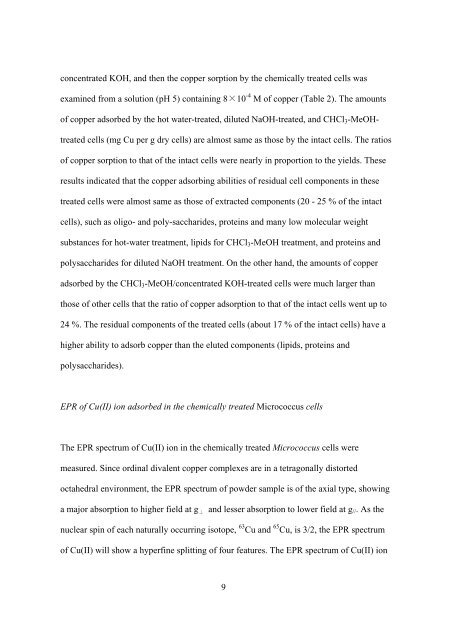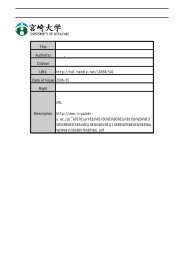Micrococcus luteus - 宮崎大学
Micrococcus luteus - 宮崎大学
Micrococcus luteus - 宮崎大学
Create successful ePaper yourself
Turn your PDF publications into a flip-book with our unique Google optimized e-Paper software.
concentrated KOH, and then the copper sorption by the chemically treated cells was<br />
examined from a solution (pH 5) containing 8×10 -4 M of copper (Table 2). The amounts<br />
of copper adsorbed by the hot water-treated, diluted NaOH-treated, and CHCl3-MeOH-<br />
treated cells (mg Cu per g dry cells) are almost same as those by the intact cells. The ratios<br />
of copper sorption to that of the intact cells were nearly in proportion to the yields. These<br />
results indicated that the copper adsorbing abilities of residual cell components in these<br />
treated cells were almost same as those of extracted components (20 - 25 % of the intact<br />
cells), such as oligo- and poly-saccharides, proteins and many low molecular weight<br />
substances for hot-water treatment, lipids for CHCl3-MeOH treatment, and proteins and<br />
polysaccharides for diluted NaOH treatment. On the other hand, the amounts of copper<br />
adsorbed by the CHCl3-MeOH/concentrated KOH-treated cells were much larger than<br />
those of other cells that the ratio of copper adsorption to that of the intact cells went up to<br />
24 %. The residual components of the treated cells (about 17 % of the intact cells) have a<br />
higher ability to adsorb copper than the eluted components (lipids, proteins and<br />
polysaccharides).<br />
EPR of Cu(II) ion adsorbed in the chemically treated <strong>Micrococcus</strong> cells<br />
The EPR spectrum of Cu(II) ion in the chemically treated <strong>Micrococcus</strong> cells were<br />
measured. Since ordinal divalent copper complexes are in a tetragonally distorted<br />
octahedral environment, the EPR spectrum of powder sample is of the axial type, showing<br />
a major absorption to higher field at g ⊥ and lesser absorption to lower field at g//. As the<br />
nuclear spin of each naturally occurring isotope, 63 Cu and 65 Cu, is 3/2, the EPR spectrum<br />
of Cu(II) will show a hyperfine splitting of four features. The EPR spectrum of Cu(II) ion<br />
9




